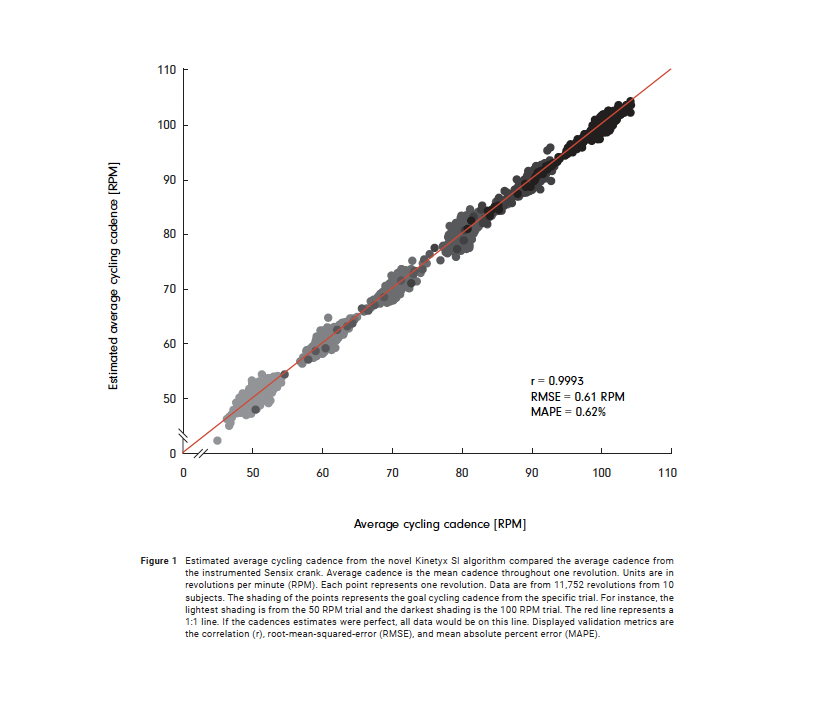Validation of cycling cadence using the Kinetyx insole
Authors: Eric C. Honert¹, Sadhiq Nazeer¹, Sandro R. Nigg¹, Benno M. Nigg¹, Sam Blades²
1 University of Calgary
2 Kinetyx Sciences Inc.
Highlight
The novel Kinetyx algorithm reliably estimates cycling cadence.
Background
Cycling is a common mode of transportation and method of exercise. Both recreation and competitive cyclists benefit from the use of mobile technology to track their workouts and understand their performance. These technologies provide a range of important cycling metrics such as speed, cadence and cycling power. For instance, cadence, which is the number of pedal revolutions per minute (RPM), has been shown to play a central role in cycling economy and performance (Ansley and Cangley 2009). Additionally, cyclists can benefit from tracking their cycling power as this is related to the rate of oxygen consumption (Hawley and Noakes 1992). A greater amount of oxygen consumption means better performance as more oxygen is being delivered to muscles to perform the activity (Coyle et al. 1991). Despite the importance of these cycling measurement technologies, many power meters on the market cost above $500 and require replacing the bicycle pedals or crank, making the technology prohibitive to many. An alternative low-profile and low-cost solution could be the Kinetyx insole, which combines inertial measurement units (IMUs) and plantar pressure, to compute cycling cadence and power. A first step in the computation of cycling power is estimating cycling cadence (i.e. the angular velocity of the crank) as cycling cadence multiplied by torque equates to cycling power. As such, the purpose of this white paper is to assess the validity of a novel real-time cycling cadence algorithm using the Kinetyx insole.
Methods
Ten recreationally active subjects provided written informed consent and participated in this study. The protocol was approved by the University of Calgary’s Conjoint Health Research Ethics Board (REB20- 1734). Subjects cycled on a VeloTron cycle ergometer (Racer-Mate, Seattle, WA, USA) for six different conditions that were three minutes in length. In each condition, participants followed a stair-step power profile that increased the cycling power from 100W to 150W to 200W. Participants cycled at each power for one minute. For each condition, the participants maintained a desired cadence with real-time feedback from the VeloTron CS software. The different cadences were 50, 60, 70, 80, 90, and 100 RPM. Data were collected simultaneously from Sensix instrumented pedals and crank (Sensix, Poitiers, FRA) and from the Kinetyx insoles. All participants were allowed to rest between each condition.
The ten participants yielded a total of 11,572 revolutions available for analysis. Real-time average cycling cadence was derived using a novel algorithm with the Kinetyx insole and provides an estimate of cycling cadence once per cycle. The estimated cycling cadence was then validated against the average crank velocity per cycle from Sensix using root mean square error (RMSE), mean absolute percent error (MAPE), and Pearson’s correlation (r).
Results
The novel cycling cadence algorithm accurately predicted cadence across a wide range of cycling cadences. On average the correlation between measured and estimated average cadence was 0.9993 and was as high as 0.9998 for one subject. No subject had a correlation below 0.99. On average the RMSE between measured and estimated average cadence was 0.61 RPM and was as low as 0.36 RPM for one subject. The RMSE was not above 0.9 RPM for any subject. On average the MAPE between measured and estimated average cadence was 0.62% and was as low as 0.37% for one subject. The MAPE was not above 1% for any subject.
Summary
The novel, real-time Kinetyx insole algorithm reliably estimated cycling cadence across a wide range of cadences. Such a reliable estimate can provide valuable real-time feed-back to cyclists regarding their economy and performance (Ansley and Cangley 2009) and will aid in future developments of cycling power algorithms leveraging the Kinetyx insole.
References
Ansley, Les, and Patrick Cangley. 2009. “Determinants of ‘Optimal’ Cadence during Cycling.” European Journal of Sport Science 9 (2): 61–85. https://doi.org/10.1080/17461390802684325.
Coyle, E. F., M. E. Feltner, S. A. Kautz, M. T. Hamilton, S. J. Montain, A. M. Baylor, L. D. Abraham, and G. W. Petrek. 1991. “Physiological and Biomechanical Factors Associated with Elite Endurance Cycling Performance.” Medicine & Science in Sports & Exercise 23 (1): 93–107.
Hawley, John A., and Timothy D. Noakes. 1992. “Peak Power Output Predicts Maximal Oxygen Uptake and Performance Time in Trained Cyclists.” European Journal of Applied Physiology and Occupational Physiology 65 (1): 79–83. https://doi.org/10.1007/BF01466278.

